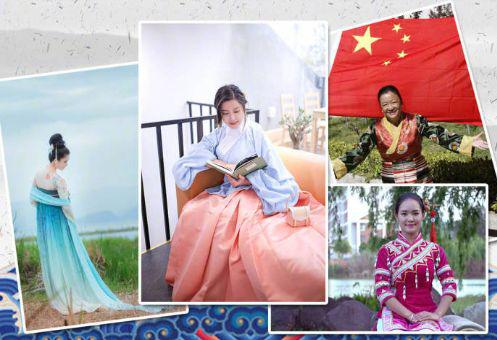时间:2020-04-17 03:09:41 来源:新浪教育_新浪网作者:黑龙江省阿城市
农历的三月初三,上巳节,是“中国华服日”。
你或许要问了:华服日……是什么?
由共青团中央和B站共同发起的首届“中国华服日”,定在了农历三月初三——

“华服”,即中华民族的传统服装。
她可以是环佩玎珰的苗服,大气厚重的藏袍,华丽富贵的旗装……更可以是咱们汉族的汉服。

(图via共青团中央)
以下是Global Times (Metro Shanghai)今天刊登的一篇评论,部分配有中文翻译。
Applause for first Traditional Chinese Costume Day
April 18 marks the first-ever Traditional Chinese Costume Day, an event co-organized by the Central Committee of the Communist Youth League and anime-streaming platform bilibili.com to encourage young Chinese of all ethnic groups to wear their traditional clothing.
今天是首届“中国华服日”。这是由共青团中央和B站共同举办的活动,旨在鼓励中国各民族的年轻人们穿上自己的传统服装。
Hanfu, the traditional clothing of Han people, was worn for several thousand years. It is delicate and elegant, perfectly showing oriental aesthetics as well as the beauty of traditional Chinese painting and embroidery.
汉民族的传统服饰“汉服”,已经流行了几千年。它精致优雅,将东方美学与中国绘画及刺绣的匠心展现得淋漓尽致。

(图via了不起的匠人)
It's a pity that hanfu started fading away during the Qing Dynasty (1644-1911), when Manchu people from northeast China ruled the country and forced Hans to wear Manchu clothing. From then on, hanfu was gradually forgotten, leaving the world's largest ethnic group with no idea what their traditional clothes looked like.
遗憾的是,在清朝,当满族人南下并强迫汉人剃发易服时,汉服就开始消逝,逐渐被历史所遗忘。汉族——这一全世界最大的民族——竟从此不知自己的传统服装是什么模样了。
Years ago, as a child, I saw a group photo of children from China's 56 ethnic groups in a textbook. In the photo, everyone wore traditional costumes from their own ethnic group - except the Han boy, who wore a simple, featureless Western-style T-shirt.
很多年前,当我还是枚小盆友的时候,有次在语文课本里看到了中国56个民族的儿童合影。照片中,所有的小盆友都穿着各自的民族服装——除了汉族的那个小男孩,就穿着件特别简单且毫无特色的T恤。
Later, when historical dramas began inundating our TV screens in the early 2000s, I was tormented by their poorly designed, curtain-like costumes. Most of them looked disappointingly ugly and shoddy, not to mention historically inaccurate.
之后,到了2000年初,各种古装剧充斥了电视屏幕。许多粗制滥造跟窗帘布一样的戏服,又丑又廉价,真是看着就辣眼睛……更别提有什么历史依据了。

Most ancient Chinese clothes were made of pure silk, cotton or linen, which were very difficult to preserve. To date, few complete sets of hanfu have been preserved, as the vast majority were destroyed by corrosion and oxidation. Prior to the recent "hanfu renaissance," the public knew little about this traditional costume.
很多中国古时的衣服都以丝、棉、麻等制成,不易保存。故此,迄今出土的完整汉服寥寥无几(尤其宋明以前),绝大多数都因腐蚀和氧化而香消玉殒。在近年来的“汉服复兴”之前,公众鲜少了解咱们的传统服装。
Fortunately, hanfu is making a comeback with a rising number of people discovering and realizing the beauty of it. The first media coverage of modern Chinese wearing hanfu can be traced back to 2003, when a man named Wang Letian in Central China's Henan Province made Han Dynasty (206BC - AD220) style hanfu according to ancient paintings, then wore it out on the streets, Singapore-based Lianhe Zaobao newspaper reported.
幸运的是,随着越来越多的人开始发觉并感受到它的美,如今汉服正在归来。已知最早关于现代人穿汉服的媒体报道出自2003年的新加坡《联合早报》,说的是河南一位名叫王乐天的人穿着周制汉服走上了街头。这套汉服正是他根据古画等资料自制的。
Two years later, Wang told domestic media that wearing hanfu made him a "monster" in the eyes of other ordinary citizens. "Some called me Japanese," he added. "I had to repeat that I am Chinese," reported Jiangsu-based Nanjing Daily in 2005.
两年后,王乐天向《南京日报》回忆说,当时他穿着汉服上街,在路人眼里仿佛是个“怪物”。“还有人叫我日本人,”他说。“我只能不断重复:我是中国人!”
The public's grave misunderstanding of hanfu is one of the biggest obstacles that the hanfu renaissance has encountered. In 2010, some men in Chengdu, capital of Southwest China's Sichuan Province, forcibly removed a young woman's hanfu clothing off her body, then burned it in public, ifeng.com reported. Mistaking her Zhou Dynasty (1046BC-256BC) hanfu for a Japanese traditional costume, these ignorant hyper-nationalists assaulted the woman and destroyed her hanfu just to satisfy their misguided anti-Japanese feelings.
汉服复兴中遇到的最大阻力之一便是公众的误解。据凤凰网报道,2010年,成都一个穿着曲裾的姑娘被一群人强行要求脱了衣服,还把衣服给烧掉了。理由?他们以为姑娘穿的是和服

就因为无知,以及谜一样的民族主义情绪,这些愤青们戳爽了自己的反日G点,却把同胞的民族服装给当众毁了。荒不荒唐?
With a common Confucian cultural background, Chinese and Japanese traditional clothing do look similar in some regards. But they are not the same. Sadly, most modern Han people know nothing about their own traditional clothes.
中国和日本同处儒家文化圈,两国的传统服饰看上去有类似之处,这也很寻常。但汉服与和服毕竟不是一回事。只可惜,当代大多数汉族人对自己传统服装还真是一无所知。


Almost all hanfu fans have encountered similar embarrassing experiences, myself included. Whenever I wear my own hanfu out in public, there are always curious passersby who ask whether I am a Japanese, a South Korean, a cosplayer or an opera actress. Once I even heard two women behind me whispering that I looked like a prostitute.
几乎所有的汉服爱好者都有过一些尴尬的经历,我自己也不例外。穿汉服出门,总有人爱问我是不是日本人/韩国人/coser/唱戏的……更过分的是,有次我穿着汉元素齐胸在商场里晃着,听到俩妹纸在我背后窃窃私语:你看她像不像以前时候的那种妓女?

Nonetheless, such ignorance and insults seem to have compelled hanfu fans to be even bolder. Instead of getting angry, we patiently explain to these people that it is the traditional costume of our Han people. Through our continued efforts, more and more people will become familiar with this clothing.
好吧……尽管如此,公众的无知与无礼,只会促使汉服爱好者们更加坚定。相比起生闷气,我们更愿意耐心地向大家解释,这是咱们汉族的传统服装。相信通过我们的不断努力,一定会有越来越多的人不再对汉服陌生。
It's good to see that, after years of nongovernmental publicity of hanfu, authorities have finally initiated Traditional Chinese Costume Day in China, popularizing hanfu as well as the clothing of China's other ethnic minorities. As an important part of our culture, China's rich traditions and cultural confidence will help increase our collective sense of national identity.
在民间推动汉服复兴十余年后,如今官方愿意发起“中国华服日”的活动,宣传普及汉服及其他少数民族的服装,这着实令人高兴。服饰是文化的重要组成部分,增进对民族服装的了解,能让我们更好地弘扬传统,加强文化自信,提升民族认同感。始于衣冠,达于博远。❤

原文/翻译:lanlan
图:Chen Xia、网络
更多精彩讯息请关注:
微博:@环球时报英文上海版
bilibili:@歪果仁在中国
一直播:@歪果仁在中国
本文网址:http://www.gaoduanedu.cn/jiangzhangbang/35831.html
声明:本站原创/投稿文章所有权归【高端教育】所有,转载务必注明来源;文章仅代表原作者观点,不代表【高端教育】立场;如有侵权、违规,可直接反馈本站,我们将会作删除处理。
推荐文章
热文排行
热门标签
联系我们
服务热线 :027-51118219
业务 QQ :1440174575
投稿邮箱 :1440174575@qq.com